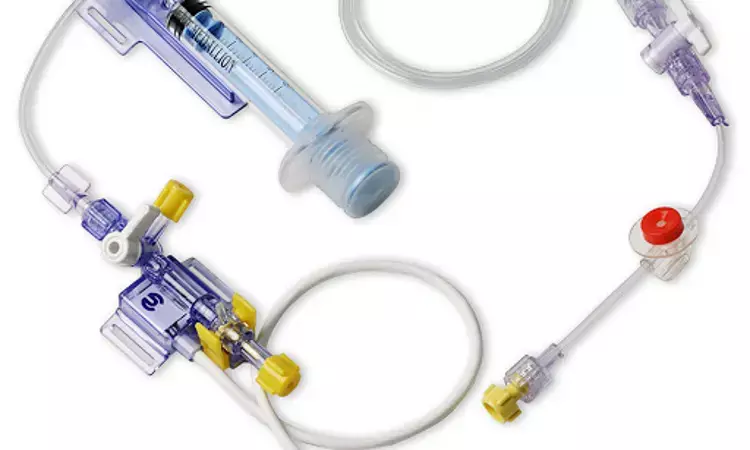- Home
- Medical news & Guidelines
- Anesthesiology
- Cardiology and CTVS
- Critical Care
- Dentistry
- Dermatology
- Diabetes and Endocrinology
- ENT
- Gastroenterology
- Medicine
- Nephrology
- Neurology
- Obstretics-Gynaecology
- Oncology
- Ophthalmology
- Orthopaedics
- Pediatrics-Neonatology
- Psychiatry
- Pulmonology
- Radiology
- Surgery
- Urology
- Laboratory Medicine
- Diet
- Nursing
- Paramedical
- Physiotherapy
- Health news
- Fact Check
- Bone Health Fact Check
- Brain Health Fact Check
- Cancer Related Fact Check
- Child Care Fact Check
- Dental and oral health fact check
- Diabetes and metabolic health fact check
- Diet and Nutrition Fact Check
- Eye and ENT Care Fact Check
- Fitness fact check
- Gut health fact check
- Heart health fact check
- Kidney health fact check
- Medical education fact check
- Men's health fact check
- Respiratory fact check
- Skin and hair care fact check
- Vaccine and Immunization fact check
- Women's health fact check
- AYUSH
- State News
- Andaman and Nicobar Islands
- Andhra Pradesh
- Arunachal Pradesh
- Assam
- Bihar
- Chandigarh
- Chattisgarh
- Dadra and Nagar Haveli
- Daman and Diu
- Delhi
- Goa
- Gujarat
- Haryana
- Himachal Pradesh
- Jammu & Kashmir
- Jharkhand
- Karnataka
- Kerala
- Ladakh
- Lakshadweep
- Madhya Pradesh
- Maharashtra
- Manipur
- Meghalaya
- Mizoram
- Nagaland
- Odisha
- Puducherry
- Punjab
- Rajasthan
- Sikkim
- Tamil Nadu
- Telangana
- Tripura
- Uttar Pradesh
- Uttrakhand
- West Bengal
- Medical Education
- Industry
Non-invasive BP measurement cannot replace Invasive blood pressure in Pediatric ICU :Study

In an intensive care unit, blood pressure (BP) recording is an integral part of hemodynamic monitoring for quick therapeutic decisions. Though Non-invasive BP (NIBP) monitoring by an oscillatory automated device is a widely accepted and most feasible modality in most clinical settings, Invasive BP(IBP) monitoring after placing an intra-arterial catheter is considered the gold standard as it provides continuous, reliable, and beat to beat monitoring of the BP.
Several studies have compared the accuracy of NIBP to IBP in intensive clinical care settings, there are fewer such studies in the pediatric cardiac critical care setting. Dr Amit Kumar et al conducted a study to compare IBP and NIBP recording in a PICU unit. The findings of this study are published in latest issue of Indian Pediatrics Journal.
In this observational prospective study a total of 45 children aged 1-18 years with intra-arterial lines as per standard management protocol were enrolled. NIBP measurement was done by the oscillatory method and IBP measurement was performed with an appropriately sized arterial catheter inserted into the radial/femoral artery and connected to a disposable pressure transducer.NIBP was measured every 4 hourly and the corresponding IBP reading was recorded. A total of 839 upper limb NIBP measurements, 834 femoral line, and 137 radial line blood pressure readings were analysed.
Key findings of the study are:
-Researchers observed that the mean difference (95% CI) for agreement between NIBP and IF(invasive femoral) line was -2.3 (-27.1, 22.5) mm Hg for systolic, 0.9 (-21.3, 23.1) mmHg for diastolic and 0.3 (-23.3, 23.9) mm Hg for mean blood pressure.
- The mean difference (95% CI) for agreement between NIBP and IR(invasive radial) line was -0.5 (-23.2, 22.3) mmHg for systolic, 2.1 (-19.6, 23.8) mmHg for diastolic and 2.3 (-19.1, 23.6) mmHg for mean blood pressure.
- There was a mean difference (95% CI)of 0.3 (-21.5, 22.2) mm Hg for systolic, -0.6 (- 15.8, 14.7) mmHg for diastolic and 0.7 (-13.7, 15.1) mm Hg for mean blood pressure between IF and IR lines.
Unlike wide differences between NIBP and IBP reported in earlier studies, NIBP gave lower readings for systolic and higher for diastolic in comparison with both IF or IR as expected norms but with a minimal difference. The present study did not find significant difference between upper limb (NIBP or IR) and lower limb (IF) blood pressure unlike normal physiological variation.
Authors conclude-" IBP cannot be replaced with NIBP, but rather should supplement with NIBP when in doubt in an ICU setup."
Source: Kumar A, Thacker JP, Chaudhary M, Phatak AG, Nimbalkar SM. Agreement Between Non-Invasive (Oscillatory) and Invasive Intra-Arterial Blood Pressure in the Pediatric Cardiac Critical Care Unit. Indian Pediatr. 2021 Jul 15;58(7):643-646.
Dr Kamal Kant Kohli-MBBS, DTCD- a chest specialist with more than 30 years of practice and a flair for writing clinical articles, Dr Kamal Kant Kohli joined Medical Dialogues as a Chief Editor of Medical News. Besides writing articles, as an editor, he proofreads and verifies all the medical content published on Medical Dialogues including those coming from journals, studies,medical conferences,guidelines etc. Email: drkohli@medicaldialogues.in. Contact no. 011-43720751


